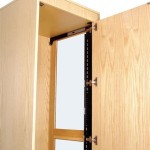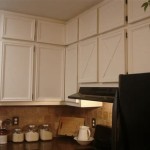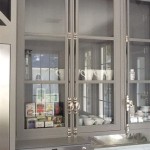How to Clean Wood Cabinets for a Fresh and Like-New Look
Wood cabinets, a common feature in kitchens and bathrooms, contribute significantly to a room's aesthetic appeal. However, their functionality subjects them to daily exposure to grease, grime, dust, and spills. Regular and proper cleaning is essential to maintain their beauty, prolong their lifespan, and prevent the buildup of stubborn stains that can be difficult to remove.
The accumulation of dirt and grease can dull the finish of wood cabinets, making them appear aged and worn. Neglecting regular cleaning can also lead to the development of a sticky residue that attracts more dust and debris. Over time, this buildup can damage the cabinet's protective coating, exposing the wood to moisture and potentially causing warping or discoloration. Therefore, a proactive cleaning routine is crucial for preserving the integrity and appearance of wood cabinets.
The approach to cleaning wood cabinets requires consideration of the cabinet's finish. Different finishes, such as painted, stained, or varnished surfaces, may react differently to various cleaning agents. Using harsh chemicals or abrasive materials can damage the finish, leading to scratches, discoloration, or peeling. Therefore, understanding the type of finish and selecting appropriate cleaning products are essential steps in the cleaning process.
This article outlines a comprehensive guide to cleaning wood cabinets, offering practical steps and recommendations for achieving a fresh and like-new appearance while preserving the integrity of the wood and its finish. It covers essential preparations, cleaning techniques, and preventative measures to ensure the longevity and beauty of wood cabinets.
Key Point 1: Preparation and Gathering Essential Supplies
Before commencing the cleaning process, proper preparation is crucial to minimize potential damage and ensure an efficient workflow. This involves gathering the necessary cleaning supplies and taking steps to protect the surrounding areas.
First, assemble the following cleaning supplies: a soft, lint-free cloth (microfiber cloths are ideal), a soft-bristled brush (an old toothbrush works well for crevices), a bucket or bowl, warm water, mild dish soap, white vinegar (optional), baking soda (optional), mineral oil or wood polish (for conditioning), and a spray bottle (optional).
Mild dish soap is a gentle yet effective cleaning agent for removing grease and grime. Avoid using harsh detergents or abrasive cleaners, as these can damage the cabinet's finish. White vinegar is a natural degreaser and can be used to tackle stubborn stains, but it should be diluted with water to avoid damaging the finish. Baking soda is a mild abrasive that can be used to remove stuck-on food particles, but it should be used sparingly and with caution.
Next, protect the surrounding areas from potential spills or splatters. Lay down a drop cloth or old towels on the floor to protect it from drips. Remove any items from the countertops that may be affected by the cleaning process. Open windows or turn on the exhaust fan to provide adequate ventilation.
Before applying any cleaning solution to the entire cabinet surface, test it on an inconspicuous area to ensure it does not damage the finish. This will help to identify any potential adverse reactions and prevent widespread damage. Choose an area such as the inside of a cabinet door or a corner that is not easily visible.
Key Point 2: Step-by-Step Cleaning Process
Following a systematic cleaning process is essential to ensure that all surfaces are thoroughly cleaned and that no areas are overlooked. This involves removing loose debris, cleaning the surfaces with a gentle cleaning solution, and drying the cabinets thoroughly.
Begin by removing any loose debris from the cabinet surfaces. Use a soft, dry cloth or a vacuum cleaner with a brush attachment to dust the cabinets, paying attention to crevices and corners where dust tends to accumulate. This step will prevent the dust from mixing with the cleaning solution and creating a muddy mess.
Next, prepare a cleaning solution by mixing warm water with a small amount of mild dish soap. The water should be warm, but not hot, as hot water can damage the finish. Use only a few drops of dish soap per gallon of water. Avoid using excessive amounts of soap, as this can leave a residue that is difficult to remove.
Dampen a soft, lint-free cloth with the cleaning solution and gently wipe down the cabinet surfaces. Avoid saturating the cloth, as excessive moisture can seep into the wood and cause damage. Work in small sections, starting from the top and working your way down. Pay attention to areas that are particularly greasy or dirty, such as around the stove or sink.
For stubborn stains or grease buildup, create a paste of baking soda and water. Apply the paste to the affected area and let it sit for a few minutes before gently scrubbing with a soft-bristled brush. Rinse the area thoroughly with a clean, damp cloth to remove any residue. If using white vinegar, dilute it with water in a 1:1 ratio and apply it to the stain. Let it sit for a few minutes before wiping it away with a clean, damp cloth.
After cleaning, rinse the cabinets with a clean, damp cloth to remove any soap residue. Be sure to wring out the cloth thoroughly to avoid leaving excess moisture on the surface. Pay particular attention to rinsing areas where baking soda or vinegar were used, as these can leave a residue if not properly removed.
Finally, dry the cabinets thoroughly with a clean, dry cloth. This step is crucial to prevent water spots and moisture damage. Use a soft, lint-free cloth to gently pat the cabinets dry. Pay attention to crevices and corners, where moisture tends to accumulate.
Key Point 3: Conditioning and Maintenance
After cleaning, conditioning the wood cabinets can help to restore their luster and protect them from future damage. Regular maintenance is also essential to prevent the buildup of dirt and grime and to prolong the lifespan of the cabinets.
Apply a thin layer of mineral oil or wood polish to the cabinets using a clean, soft cloth. Mineral oil helps to moisturize the wood and prevent it from drying out and cracking. Wood polish can help to restore the shine and protect the finish from scratches and stains. Follow the manufacturer's instructions for application and buffing. Be sure to use a product that is specifically designed for wood cabinets and that is compatible with the cabinet's finish.
Avoid using furniture polish that contains silicone, as this can create a buildup that is difficult to remove and can attract dust. Also, avoid using abrasive polishes, as these can scratch the finish.
To maintain the cleanliness of wood cabinets, establish a regular cleaning routine. Wipe down the cabinets with a damp cloth at least once a week to remove dust and spills. Clean up any spills or splatters immediately to prevent them from staining the wood.
Avoid using harsh chemicals or abrasive cleaners on wood cabinets, as these can damage the finish. Use mild dish soap and water for regular cleaning and reserve stronger cleaning agents for stubborn stains. Protect the cabinets from excessive moisture by ensuring proper ventilation in the kitchen and bathroom. Avoid placing wet items directly on the cabinets and wipe up any spills immediately.
Periodically inspect the cabinets for any signs of damage, such as scratches, chips, or water stains. Repair any damage promptly to prevent it from worsening. Use wood filler to repair scratches and chips and apply a sealant to protect the repaired areas from moisture.
Consider using cabinet liners to protect the shelves from spills and scratches. Cabinet liners are available in a variety of materials, such as plastic, rubber, and paper. Choose a liner that is easy to clean and that will not damage the cabinet's finish.
By following these steps, homeowners can effectively clean and maintain their wood cabinets, ensuring that they retain their beauty and functionality for years to come. Regular cleaning and preventative measures are essential for preserving the integrity of the wood and its finish, resulting in a fresh and like-new appearance.
Implementing these cleaning and maintenance practices not only enhances the aesthetic appeal of the kitchen or bathroom but also contributes to a healthier living environment by minimizing dust and allergens. Consistent care and attention will ensure that wood cabinets remain a valuable and attractive feature of the home.
Furthermore, understanding the specific type of wood and finish of the cabinets allows for the selection of the most appropriate cleaning and conditioning products, ensuring optimal results and preventing potential damage. Always refer to the manufacturer's recommendations for specific care instructions.

7 Ways To Keep Your Kitchen Cabinets Clean Looking New

Best Way To Properly Clean Wood Kitchen Cabinets Cabinetry

Update Kitchen Cabinets No Sanding

How To Clean Wood Cabinets And Make Them Shine

How To Make Old Wood Cabinets Look New Without Sanding

How To Clean Wood Cabinets Like A Pro Step By Guide

How To Stain Your Wood Cabinets Darker Young House Love

8 Cleaning S To Clean Kitchen Cabinets Specialty Bath

How To Clean Kitchen Cabinets

Safely Clean New Wood Cabinets Cleaning
Related Posts








